Chapter 3: The law of torts
Chapter learning objectives
Upon completion of this chapter you will be able to:
- define a tort and show how it is different from a contract
- explain the elements of negligence
- discuss defences to an action in negligence
- relate the basic principles to accountants
- explain the basics of passing off.
1 Understand the nature of the law of tort
What is a tort?
 A tort is a type of civil wrong. It is a breach of a legal duty or an infringement of a legal right which gives rise to a claim for damages.
A tort is a type of civil wrong. It is a breach of a legal duty or an infringement of a legal right which gives rise to a claim for damages.
As a tort is a breach of a legal duty, there is no liability unless the law recognises that the duty exists.
Differences between contracts and torts
A contractual relationship does not have to be established for a claim in tort to be successful. Often the parties have never even met before. For example, in a claim for personal injury as a result of a road accident, the parties will often have had no previous relationship at all.
However, if a contract does exist and a tort has been committed, the claimant may choose the remedy most appropriate.
There are two options:
- Under a valid contract, the amount of damages awarded is intended to put the claimant back in the position he would have been in had the contract been properly performed.
- In tort, the amount of damages awarded is intended to put the claimant in the position he would have been in had the tortious act never taken place.
Limitation periods
- In contract the limitation period is six years from the breach of contract.
- In tort the limitation period is generally six years, but three years for personal injury.
The main elements of a tort
In order to be successful in an action for tort, the following conditions must be satisfied:
- There must be an act or omission by the defendant.
- The act or omission must have directly caused loss to the claimant.
- The courts must be able to establish a legal liability as a result of the damage.
A claim will only be successful if the loss suffered is not 'too remote' i.e. the loss must be as a direct consequence of something the defendant did/or did not do.
2 Types of Tort
Nuisance
The tort of nuisance allows a claimant to sue for most acts that interfere with their use and enjoyment of their land.
The tort of nuisance is separated into private nuisance and public nuisance.
Private Nuisance
The law recognises that landowners, or those in rightful possession of land, have the right to reasonable comfort and convenience in its occupation.
Public Nuisance
Under criminal law, public nuisance is a class of common law offence in which the injury, loss or damage is suffered by the local community as a whole rather than by individual victims.
Examples include a manufacturer who has polluted a stream, the keeping of diseased animals or shooting fireworks in the street.
Trespass to Land
Trespass to land occurs where a person directly enters upon another's land without permission, or remains upon the land, or places or projects any object upon the land.
This tort is actionable per se without the need to prove damage.
Trespass to Person
Generally, trespass to the person consists of three torts: assault, battery, and false imprisonment.
Battery is the tort of intentionally and voluntarily bringing about an unconsented harmful or offensive contact with a person. There must be actual contact.
Assault is the intentional act of putting an individual in reasonable fear or apprehension of immediate battery. There does not need to be actual battery and therefore not necessarily any contact.
False imprisonment is where a person is unlawfully arrested, imprisoned or prevented from leaving where they are.
3 Negligence
Negligence is the breach of a legal duty to take care, which results in damage to another.
In order for an action in negligence to succeed, the claimant must prove the following:
- That a duty of care was owed to him by the defendant
- The defendant breached that duty
- As a consequence of that breach, damage or loss has been suffered.
Duty of care
There is a duty to take reasonable care not to cause foreseeable harm to others.
The 'neighbour principle'
The case of Donoghue v Stevenson (below) was the first to establish that a duty of care may be owed to a person, even where no contractual relationship exists.
Prior to this case, the belief was that to allow an action to be taken where there was no contractual relationship would undermine the principles of contract law. The doctrine of privity states that only parties to a contract can sue or be sued.
Donoghue v Stevenson changed this principle and, as a result, manufacturers of goods owe a duty of care to the ultimate consumer of the product.
Donoghue v Stevenson (1932)
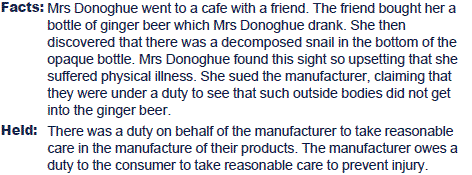
Lord Atkin defined those to whom we owe a duty of care in the 'neighbour principle':
You must take reasonable care to avoid acts or omissions which you ought reasonably foresee would be likely to injure your neighbour.’
He defined neighbours as:
'...persons who are so directly affected by my act that I ought reasonably to have them in contemplation'.
The duty of care, which in Donoghue v Stevenson just related to physical harm has been extended in subsequent cases.
Bourhill v Young (1943)
In this case the court established that the duty of care could apply to nervous shock provided there was sufficient proximity i.e. that the shock was suffered by someone within the reasonable range of harm.
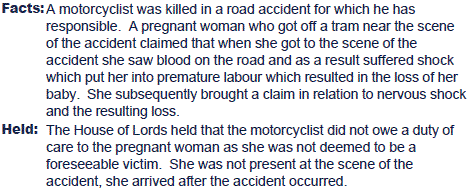
White v Chief Constable of South Yorkshire Police (1998)
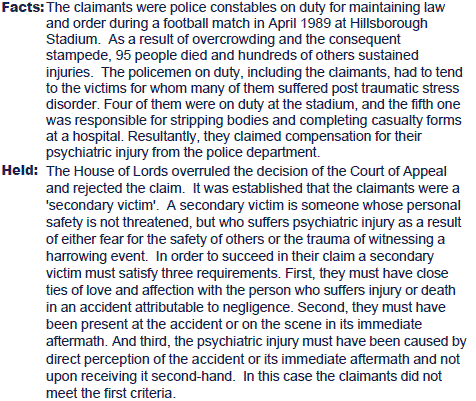
Economic or financial loss
The case of Donoghue v Stevenson (1932) established that an action could be taken if physical damage was suffered. However, the law still did not recognise liability in respect of 'pure' economic loss. Pure economic loss is monetary loss which is unconnected to physical injury to a person or damage to other property. Where there is economic loss that is connected to physical injury or damage to property then that is 'consequential' economic loss which is recoverable.
Spartan Steel & Alloys Ltd v Martin & Co (Contractors) Ltd (1973)
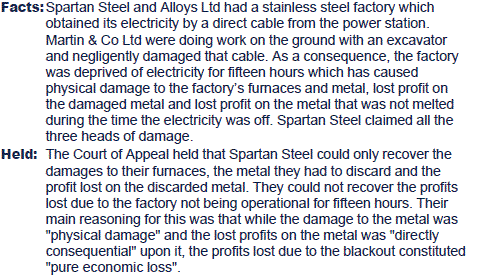
In respect of pure economic loss suffered as a result of professional misstatement the case of Hedley Byrne v Heller modernised the law in this area. The House of Lords refined the neighbour principle by acknowledging that a claim for financial loss suffered could be made if a 'special relationship' existed between the claimant and defendant (see part 3).
The limits of the duty of care
In the case of The Nicholas H (Marc Rich & Co v Bishops Rock Marine) (1995), four tests were laid down which should be followed in determining whether a duty of care exists.
The issues to be considered are:
- Was the damage reasonably foreseeable by the defendant at the time of the act or omission?
- Is there a neighbourhood principle or sufficient proximity (closeness) between the parties?
- Should the law impose a duty of care between the parties i.e. is it fair and reasonable to do so?
- Is there a matter of public policy which exists or requires that no duty of care should exist?
The Nicholas H case focused on financial loss, but these tests should also be applied when determining the duty of care for physical damage cases.

 Illustration – Negligence
Illustration – Negligence
A was given an ipod for his birthday by his uncle. Due to a design defect, it set fire to his bedroom and caused damage to carpets and furniture. A was made ill by smoke inhalation. A is entitled to claim damages from the ipod manufacturer for:
(1)pain and suffering caused by smoke inhalation
(2)any loss of earnings whilst he recovers
(3)the cost of replacing furnishings and redecoration.
He is not entitled to claim the cost of replacing the defective ipod which would be pure economic loss.
The defect does not give rise to the liability: it is the resultant damage to person or property.


 Test your understanding 1
Test your understanding 1
In assessing whether a duty of care exists, which of the following tests will be taken into consideration?
IWas the damage reasonably foreseeable by the defendant at the time of the act or omission?
II Was it fair and reasonable for the law to impose a duty of care?
IIIHas the defendant intentionally caused physical damage or financial loss?
IVHas the claimant taken reasonable steps to mitigate the loss suffered?
A(I) and (IV) only
B(I) and (II) only
C(III) and (IV) only
DAll of the above

Breach of duty of care
In order for a claim to be successful, a claimant must not only prove that a duty of care existed, but also that the duty was breached by the defendant.
(1)As a question of fact the claimant shows that the defendant was in breach of his duty.
The Breach
Establishing if there has indeed been a breach is a question of fact. Each case must be viewed separately on its own facts.
(2)As a question of law the claimant has to show the defendant has not shown the required standard of care.
The standard of care
The test for establishing breach of duty is an objective one and was set out in Blyth v Birmingham Waterworks Co (1856) which stated that a breach of duty occurs if the defendant:
'...fails to do something which a reasonable man, guided upon those considerations which ordinarily regulate the conduct of human affairs, would do; or does something which a prudent and reasonable man would not do.'
The reasonable man is not expected to be skilled in any particular trade or profession.
The following principles have been established by case law:
- Probability of injury/vulnerability of claimant
The degree of care required has to be balanced against the degree of risk involved in the event of the duty being breached. This means that the greater the risk of injury the more that should be done in order to prevent the injury.
Glasgow Corporation v Taylor (1922)

Children are owed a higher standard of care and a lower standard can be expected from them.
The degree of care to be exercised may be increased if the claimant is more vulnerable i.e. is young, old or less able bodied. This is based on the rule that 'you must take your victim as you find him'.
Haley v London Electricity Board (1965)

As a general rule, the level of skill and care required is that which a reasonable man would possess. However, if the defendant possesses a particular skill, i.e. he is a qualified solicitor or a qualified accountant, the standard of care expected will be that of a reasonable person with that skill.
Hindsight is irrelevant, the degree of skill is the standard required at the time of the tort.
Roe v Ministry of Health (1954)

Lack of training or the peculiarities of the defendant are not relevant. Therefore, the standard of skill expected from a trainee accountant is the same as that of any reasonable accountant.
Nettleship v Weston (1971)

Where there is a forseeable risk this must be balanced against the measures necessary to eliminate the potential risk. If the cost of these measures far outweighs the potential risk it will probably be concluded that there is no breach of duty in not eliminating the risk.
Latimer v AEC Ltd (1952)

Where a particular action is in line with common practice or custom that may be considered to be sufficient to meet the expected standard of care. However, this will not apply if the common practice itself is negligent.
Paris v Stepney BC (1951)

Loss caused by the breach
A claimant must demonstrate that he has suffered loss or damage as a direct consequence of the breach. This is sometimes called the 'But For' test - but for the actions of the defendant the claimant would not have suffered the damage.
The claimant must establish a causal link between the defendant's conduct and the damage which occurred:
- If the damage was caused by something or someone else there will be no liability on the defendant's part.
- If the claimant would have suffered the loss regardless of the defendant's conduct then he has not caused the loss.
Barnett v Chelsea and Kensington Hospital Management Commitee (1969)

- If something happened after the defendant's breach that caused or contributed to the damage then the defendant's liability will cease at that point.
- The following losses are normally recoverable:
- loss as a result of personal injury
- damage to property
- financial loss directly connected to personal injury (i.e. loss of wages).
As discussed earlier pure financial loss is very rarely recoverable.
- Even where the claimant is able to show the loss was suffered as a result of the defendant's breach the court will not allow recovery of that loss if it is considered to be too remote (see part 4 below) i.e. must be of a type of loss that is reasonably foreseeable.

 Test your understanding 2
Test your understanding 2
Which one of the following is not an essential element of the tort of negligence?
AA duty of care owed to the claimant
BA breach of the duty of care
CAn intention to cause loss or injury
DLoss or injury caused by the defendant’s breach

4 Professional advice and negligent misstatement
In practice there is no difference between liability arising from negligent misstatement and liability arising from negligent acts. A party can suffer damage by reliance on incorrect advice just as he can be injured by any other negligent conduct.
With respect to a negligent misstatement however, the consequences of this could be far-reaching and affect countless people. Because of this the law had been reluctant to impose a duty of care in the making of statements.
This situation changed in 1964 when the landmark case set out below marked a new approach to the law of negligent misstatement.
Hedley Byrne & Co Ltd v Heller & Partners Ltd (1964)

The effect of Hedley Byrne
The above case created a new duty situation by recognising liability for negligent misstatement causing economic loss in circumstances where there exists a special relationship between the parties.
Cases involving negligent misstatement are usually concerned with establishing whether or not a duty arises and it is difficult to establish clear principles to apply as the law has evolved on a case-by-case basis.
The meaning of special relationship
A special relationship exists where a professional person advises a known person who relies on the statement for a known purpose.
For an action in negligent misstatement to succeed there must be a special relationship. The considerations outlined in the Nicholas H case will still be relevant.
It is clear that liability will only arise where the defendant is in the business of giving professional advice and the statement is given in that context i.e. not on a social or informal occasion.
One important consideration is the relationship of the parties in the context of the damage suffered, for example whether the preparation of accounts is for shareholders or a potential takeover.
Jeb Fasteners Ltd v Marks, Bloom & Co (1982)
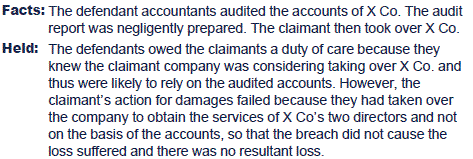
If advice is given or financial statements prepared for a specific purpose, then a duty of care is owed to those who are relying on them for that specific purpose.
Morgan Crucible v Hill Samuel Bank (1991)
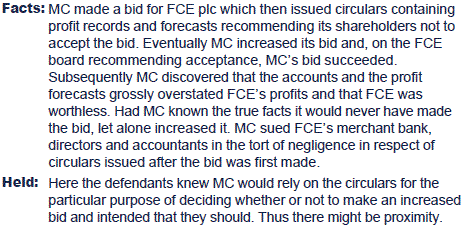
Where there is no special relationship
As a general rule, however, unless the defendant had prior knowledge that a certain bidder would rely on the statement made, no duty of care would exist.
The concept of special relationship has now been redefined in the following leading case:
Caparo Industries Plc v Dickman and Others (1990)
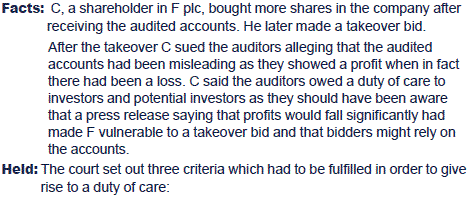
This approach is also illustrated in the following case:
James McNaughton Paper Group v Hicks Anderson (1991)


Where there is a special relationship
If advice is given or financial statements prepared for a specific purpose, then a duty of care is owed to those who are relying on them for that specific purpose.

 Test your understanding 3
Test your understanding 3
Which one of the following is correct?
AProfessional advisors cannot be liable in respect of negligent advice in the tort of negligence but may be liable for breach of contract.
BProfessional advisors cannot be liable for breach of contract in respect of negligent advice, but may be liable in the tort of negligence.
CProfessional advisors may be liable in respect of negligent advice in either contract or tort.
DProfessional advisers cannot be liable in respect of negligent advice in either contract or tort.


 Test your understanding 4
Test your understanding 4
What forms the basis of the existence of a legal duty of care in negligence for misstatements resulting in economic loss to the claimant?
AProximity
BProximity and damage
CForeseeability
Dseeability and proximity


 Test your understanding 5
Test your understanding 5
In Hedley Byrne v Heller & Partners, the House of Lords held that a banker would owe a duty of care on a reference for a client given voluntarily without consideration to a third party.
What was the basis of this decision?
AThat in such a case a duty is owed to persons generally.
BThat a duty is owed to those persons who could reasonably be foreseen as relying on the statement.
CThat a duty is owed to a person the defendant knew or ought to have known would rely on the statement.
DThat a duty is only owed to those with whom the defendant was in a fiduciary or contractual relationship.

5 Remedies and defences in negligence
Remedies in an action in negligence
The principal remedy in any case involving negligence will be an award of damages.
The damage caused to the claimant must be of a type that is 'reasonably foreseeable'.
A loss is reasonably foreseeable if a reasonable man would have foreseen the type of injury, loss or damage.
As a general rule it is for the claimant to prove that the defendant was in breach of the duty of care.
Exceptionally the defendant will have to prove that he was not negligent. This will only occur if:
- the harm would not have normally happened if proper care were taken
- there is no other explanation for what has occurred, known as res ipsa loquitor, the thing that speaks for itself
- the defendant was in control of the situation and the victim was not.
Ward v Tesco Stores Ltd (1976)

Remoteness of Damage
Overseas Tankship (UK) v Morts Dock and Engineering Co (The Wagon Mound) (1961)

If the type of damage is reasonably foreseeable the defendant is liable. It is irrelevant that the defendant might not have been able to foresee its cause or its severity.
Hughes v Lord Advocate (1963)

Defences to a claim in negligence
There are three main defences to a charge of negligence:
- contributory negligence
- volenti non fit injuria
- exclusion clauses.
Contributory negligence
If the claimant is partly responsible for his own injuries, the defendant can plead the defence of contributory negligence. The court may then reduce any damages it awards to the claimant depending on the degree to which he is judged responsible for his loss.
The onus is on the defendant to show the claimant was at fault and therefore contributed to their own injury.
It is only a partial defence, the defendant is still liable but the damages are reduced to reflect the extent for which the claimant was responsible for their own injury.
Jones v Livox Quarries (1952)

Sayers v Harlow (1958)

Volenti non fit injuria
This applies where the claimant has freely consented to the negligent act. It amounts to an agreement by the claimant to exempt the defendant from a duty of care that he would otherwise owe. Consent can be given expressly where the claimant agrees to the risk of injury, or may be implied from the claimant's conduct.
ICI v Shatwell (1964)
Facts: The plaintiff and his brother were certificated and experienced shotfirers employed by ICI Ltd in a quarry owned by the defendant company. Part of the brothers' work included wiring up detonators and checking the electrical circuits. They ignored the defendant's rules relating to safety and tested the detonators without using the shelter provided. One of the brothers was injured and claimed his brother was 50 per cent to blame for the explosion and that the employer was vicariously liable.
Held: Both brothers had impliedly consented to the risks of their actions and therefore the defendant was not liable.
Consent acts as a complete defence and no damages would be awarded if it is shown to apply.
Exclusion clauses
An exclusion clause is one which seeks to exclude or limit liability for negligence. An exclusion clause may fall within the provisions of the Unfair Contract Terms Act 1977 (see Chapter 2).
If an exclusion clause is found to be valid, this constitutes a viable defence against any action for negligence.
In addition, liability is excluded if it is possible to say that the act occurred in the course of nature i.e. that it was an 'act of god'; something beyond human foresight which the defendant could not have been expected to provide against.

 Test your understanding 6
Test your understanding 6
In the tort of negligence, if a claimant is partly responsible for his own injuries then:
ANo compensation can be recovered from the defendant.
BThe defendant is fully liable if he was mainly responsible for the injuries.
CIf the defendant was negligent he remains fully liable for all the injuries caused.
DThe compensation will be reduced to take account of the claimant’s share of the responsibility.


 Test your understanding 7
Test your understanding 7
If a claimant cannot show precisely how an accident occurred in relation to personal injuries he receives through negligence:
AHe cannot claim compensation.
BHe can only claim reduced compensation.
CThere is no effect on his claim.
DHe may assert ‘res ipsa loquitor’.

6 The tort of passing off
This tort protects the goodwill, reputation and profits of a business.
The tort of passing off arises:
- where one business uses a name which is similar to that of an existing business, and
- it misleads persons into believing that they are the same business, and
- it causes actual damage to that business or will probably do so.
Ewing v Buttercup Margarine Co Ltd (1917)

If passing off is proved, the court may restrain the business from trading under that name and order that damages be paid to the person whose business has suffered loss.
If a company feels than another company has a name which is too similar to its own, it may object to the Company Names Adjudicator under CA 06. The Adjudicator will consider the case and then make their decision. In most cases the Adjudicator will require a name change, and in some cases the Adjudicator may state the new company name.
7 Chapter summary
Test your understanding answers

 Test your understanding 1
Test your understanding 1
B
The intention of the defendant is irrelevant to a claim for negligence. The claimant is under no duty to mitigate their loss.


 Test your understanding 2
Test your understanding 2
C
The three elements of the tort of negligence are:
- Duty of care: It applies in situations where an individual owes a duty of care to someone else.
- Breach of duty of care: the claimant must show the defendant failed to take the care which a reasonable person would have done in the circumstances.
- Resultant loss: there must be a resultant loss, financial or otherwise, before the tort of negligence can be applied.
Intention to cause harm is not a prerequisite here.


 Test your understanding 3
Test your understanding 3
C
Professional advisers may be liable in respect of negligent advice in either contract or tort.


 Test your understanding 4
Test your understanding 4
D
The main element is proximity, but some likelihood of damage must have been foreseeable.


 Test your understanding 5
Test your understanding 5
C
A duty is owed to a person the defendant knew or ought to have known would rely on the statement. He must also know the purpose to which the information will be put.


 Test your understanding 6
Test your understanding 6
D
In the tort of negligence, if the claimant is partly responsible for his own injuries, the compensation awarded by the court will be reduced to take account of the claimant's share of the injuries.


 Test your understanding 7
Test your understanding 7
D
If a claimant cannot show how an accident occurred he can assert 'res ipsa loquitor'. This means that 'the thing speaks for itself'. When this doctrine is applied it is not necessary for the claimant to prove that the defendant is negligent: if there was no other way the injury could have happened the negligence of the defendant is presumed.

|
Created at 5/24/2012 3:09 PM by System Account
(GMT) Greenwich Mean Time : Dublin, Edinburgh, Lisbon, London
|
Last modified at 8/20/2012 4:35 PM by System Account
(GMT) Greenwich Mean Time : Dublin, Edinburgh, Lisbon, London
|
|
|
|
 |
Rating
:
|
 Ratings & Comments
(Click the stars to rate the page) Ratings & Comments
(Click the stars to rate the page)
|
 |
Tags:
|
|
|
|
|